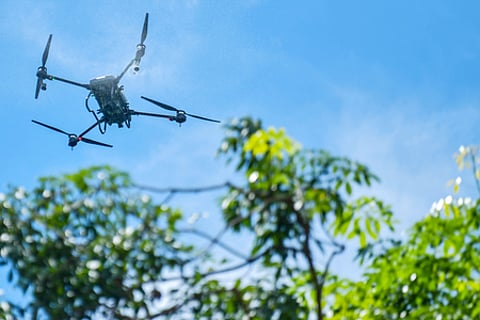
- Home
- Live Blog
- Breaking News
- Top Headlines
- Cities
- NE News
- Sentinel Media
- Sports
- Education
- Jobs

OUR CORRESPONDENT
DIGBOI: A major drone strike early on Tuesday targeted a base of the National Socialist Council of Nagaland–Khaplang (Yung Aung) faction, or NSCN-K(YA), in Myanmar’s Sagaing Region near the Indo-Myanmar border.
According to security and defence sources, the precision-guided attack destroyed key insurgent positions, killing at least five militants and leaving several others injured, including a senior NSCN-K(YA) leader. Three of the slain militants were reportedly part of the leader’s personal security detail.
Eyewitnesses described multiple explosions followed by heavy gunfire, suggesting a coordinated operation involving several drones armed with high-precision munitions.
While neither the Indian government nor the Myanmar military has issued an official statement, multiple defence and security outlets have attributed the strike to Indian forces acting across the border.
The operation is believed to be a retaliatory measure following a recent spate of militant attacks on Indian security installations in the northeastern region. Intelligence inputs indicate that the strike was executed after days of surveillance using advanced intelligence, surveillance, and reconnaissance (ISR) platforms to track insurgent activity inside Myanmar’s territory.
The drone strike comes in the wake of increased militant activity along the Indo-Myanmar frontier.
On October 16, two Assam Rifles personnel were injured in an ambush near Manmaw in Arunachal Pradesh’s Changlang district, allegedly carried out jointly by cadres of NSCN-K(YA) and the United Liberation Front of Asom–Independent (ULFA-I). The attackers, operating from across the border, reportedly used improvised explosive devices (IEDs) and automatic weapons before retreating into dense forest cover.
This assault was followed by another attack on an army camp at Kakopather in Assam’s Tinsukia district, where suspected militants opened fire on security personnel under the cover of darkness. Although there were no casualties reported in the Kakopather attack, it highlighted the growing boldness and coordination among insurgent groups operating along the sensitive border belt.
Security officials believe these consecutive attacks were part of a broader strategy by insurgent outfits to reassert their presence and disrupt peace in the Northeast. The NSCN-K(YA), which is based largely in Myanmar’s Naga-inhabited regions, has long maintained training camps and logistical networks across the border, often beyond the reach of Indian security forces.
ULFA-I, similarly, maintains close ties with NSCN-K(YA) and other Myanmar-based militant organizations, using cross-border routes to move weapons and recruits.
The recent attacks prompted Indian security agencies to intensify surveillance and consider proactive action against insurgent camps.
The use of drones in Tuesday’s operation signals a significant shift in India’s counter-insurgency strategy. For decades, India’s response to cross-border insurgency has relied on ground-based operations and coordinated intelligence sharing with Myanmar. However, the deployment of unmanned aerial systems marks a new phase—one emphasizing precision, speed, and minimal collateral damage. Defence analysts view the operation as a demonstration of India’s expanding technological capabilities and willingness to act preemptively to safeguard its borders.
At the same time, the absence of an official acknowledgement from New Delhi adds a layer of diplomatic complexity. Myanmar’s Sagaing Region has been a hotspot of armed conflict involving ethnic militias and the country’s military junta, and any external military action risks triggering sovereignty concerns. So far, both governments have remained silent, maintaining a delicate balance amid heightened security sensitivities.
As authorities await formal statements from both nations, the operation at the NSCN-K(YA) camp marks a turning point in India’s approach to insurgent sanctuaries across the border—characterised by precision, deterrence, and a clear message that cross-border aggression will be met with decisive force.
Also Read: ULFA-I & NSCN(K-YA) Attack Army Camps in Assam, Arunachal